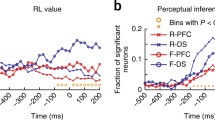Abstract
Although the human amygdala and striatum have both been implicated in associative learning, only the striatum's contribution has been consistently computationally characterized. Using a reversal learning task, we found that amygdala blood oxygen level–dependent activity tracked associability as estimated by a computational model, and dissociated it from the striatal representation of reinforcement prediction error. These results extend the computational learning approach from striatum to amygdala, demonstrating their complementary roles in aversive learning.


Similar content being viewed by others
References
Schultz, W., Dayan, P. & Montague, P.R. Science 275, 1593–1599 (1997).
O'Doherty, J.P., Dayan, P., Friston, K., Critchley, H. & Dolan, R.J. Neuron 38, 329–337 (2003).
Delgado, M.R., Li, J., Schiller, D. & Phelps, E.A. Phil. Trans. R. Soc. Lond. B 363, 3787–3800 (2008).
Davis, M. & Whalen, P.J. Mol. Psychiatry 6, 13–34 (2001).
Phelps, E.A. in The Human Amygdala (eds. Whalen, P. & Phelps, E.) 204–219 (Guilford Press, New York, 2009).
Pearce, J.M. & Hall, G. Psychol. Rev. 87, 532–552 (1980).
Holland, P.C. & Gallagher, M. Trends Cogn. Sci. 3, 65–73 (1999).
Roesch, M.R., Calu, D.J., Esber, G.R. & Schoenbaum, G. J. Neurosci. 30, 2464–2471 (2010).
Belova, M.A., Paton, J.J., Morrison, S.E. & Salzman, C.D. Neuron 55, 970–984 (2007).
Schiller, D., Levy, I., Niv, Y., LeDoux, J.E. & Phelps, E.A. J. Neurosci. 28, 11517–11525 (2008).
Courville, A.C., Daw, N.D. & Touretzky, D.S. Trends Cogn. Sci. 10, 294–300 (2006).
Preuschoff, K. & Bossaerts, P. Ann. NY Acad. Sci. 1104, 135–146 (2007).
Behrens, T.E.J., Woolrich, M.W., Walton, M.E. & Rushworth, M.F.S. Nat. Neurosci. 10, 1214–1221 (2007).
Robbins, T.W., Cador, M., Taylor, J.R. & Everitt, B.J. Neurosci. Biobehav. Rev. 13, 155–162 (1989).
Baxter, M.G. & Murray, E.A. Nat. Rev. Neurosci. 3, 563–573 (2002).
Acknowledgements
We thank P. Glimcher, R. Rutledge and E. DeWitt for discussions and comments. This research was supported by a McKnight Foundation Scholar Award, Human Frontiers Science Program grant RGP0036/2009-C, US National Institutes of Health (NIH) grant MH087882 (part of the CRCNS program, to N.D.D.), a James S. McDonnell Foundation grant and NIH grant MH080756 to E.A.P., and NIH grants DA015718 and AG027097 to G.S. This work was also supported by a Seaver Foundation grant to the Center for Brain Imaging.
Author information
Authors and Affiliations
Contributions
E.A.P. and D.S. designed the study and conducted the experiment. J.L. and N.D.D. performed the data analysis. J.L., D.S., G.S., E.A.P. and N.D.D. interpreted the data and wrote the manuscript.
Corresponding author
Ethics declarations
Competing interests
The authors declare no competing financial interests.
Supplementary information
Supplementary Text and Figures
Supplementary Figures 1–3, Supplementary Tables 1–5 and Supplementary Methods (PDF 3279 kb)
Rights and permissions
About this article
Cite this article
Li, J., Schiller, D., Schoenbaum, G. et al. Differential roles of human striatum and amygdala in associative learning. Nat Neurosci 14, 1250–1252 (2011). https://doi.org/10.1038/nn.2904
Received:
Accepted:
Published:
Issue Date:
DOI: https://doi.org/10.1038/nn.2904
- Springer Nature America, Inc.
This article is cited by
-
Trait anxiety is associated with hidden state inference during aversive reversal learning
Nature Communications (2023)
-
Mental imagery can generate and regulate acquired differential fear conditioned reactivity
Scientific Reports (2022)
-
The prefrontal cortex, pathological anxiety, and anxiety disorders
Neuropsychopharmacology (2022)
-
Common and stimulus-type-specific brain representations of negative affect
Nature Neuroscience (2022)
-
Striatal hub of dynamic and stabilized prediction coding in forebrain networks for olfactory reinforcement learning
Nature Communications (2022)





